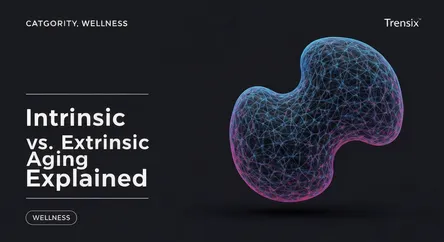Wellness
Intrinsic vs. Extrinsic Aging Explained

Discover the difference between intrinsic (genetic) and extrinsic (environmental) aging and how it impacts your skin's health and appearance.
What is it?
Skin aging is categorized into two distinct types: intrinsic and extrinsic. Intrinsic aging, also known as chronological aging, is the natural and inevitable process dictated by your genes. It involves a gradual decline in physiological functions, such as reduced collagen and elastin production, leading to thinner skin, fine wrinkles, and loss of firmness. This process generally begins in our mid-20s.
Extrinsic aging results from external environmental and lifestyle factors. The primary cause of extrinsic aging is sun exposure (photoaging), which accounts for a significant majority of visible signs of aging. Other major contributors include pollution, smoking, poor diet, and chronic stress. These factors accelerate the aging process, causing coarse wrinkles, loss of elasticity, and uneven skin tone. While intrinsic aging is unavoidable, extrinsic aging is largely preventable.
Why is it trending?
The distinction between intrinsic and extrinsic aging is a major focus in the wellness and beauty industry, which is experiencing significant growth. The global anti-aging market was valued at over $67 billion in 2021 and continues to expand. This trend is fueled by a rising consumer awareness of skincare, longevity, and the desire for personalized anti-aging solutions. Younger generations, like millennials and Gen Z, are increasingly seeking preventative treatments. There's a growing understanding that lifestyle choices have a direct impact on skin health, leading consumers to seek education on how to mitigate the effects of extrinsic aging through targeted skincare and healthier habits.
How does it affect people?
Understanding the difference between these two aging processes empowers individuals to take control of their skin's future. It highlights that while we can't change our genetics (intrinsic aging), we can significantly influence how our skin ages by addressing external factors. This knowledge encourages proactive measures like daily sunscreen use, a balanced diet, and stress management to prevent premature aging. The visible signs of aging can have a significant psychosocial impact, affecting self-esteem and confidence due to societal pressures to look young. By focusing on preventing extrinsic aging, people can feel more in control of their appearance and overall well-being, making informed decisions about skincare products and lifestyle habits that support healthier skin long-term.